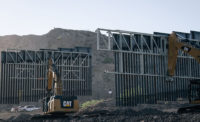Construction of the Trump administration U.S-Mexico border wall caused “irreparable” damage to natural resources, wildlife habitat, water flow and cultural sites—including blast damage to Native burial lands, erosion in protected federal property and diverted water sources that ended in flooding, a U.S. Government Accountability Office audit found.
In a rush to construct 450 miles of the barrier along the southern border, the Trump administration issued federal waivers that allowed the U.S. Dept. of Homeland Security and its U.S. Customs and Border Protection agency, as well as the U.S. Army Corps of Engineers and U.S. Defense Dept., to override environmental and natural resource protection laws from January 2017 until January 2021, when newly inaugurated President Joe Biden halted all work, the 72-page GAO audit found. Billions of dollars in DOD and other agency funding were transferred to fund wall construction.
Environmental impacts include hindering wildlife passage, including endangered species, by replacing vehicle barriers with narrower pedestrian barriers, the audit found. Native vegetation and natural water courses were also destroyed, said GAO, causing flooding during heavy downpours.
Several water sources, such as an artesian well in the San Bernardino National Wildlife Refuge in Arizona, "no longer naturally flow to the surface," partly due to barrier construction. Mechanical pumps are required to maintain water pressure, the report notes.
Arizona’s Tohono O’odham Nation told investigators that a holy site was “irreparably damaged” after construction crews expanded an existing patrol road using explosives. They also demolished saguaro cactus, found solely in the Sonoran Desert, in trying to transplant them in another area to make way for a new wall section.
Several lawsuits have been filed by environmental groups and Democratic Party-led states seeking to halt the wall over fear of its environmental impact.
Rep. Raul Grijalva (D-Ariz.), who asked for the GAO report and was a vocal critic of the wall, calling it “a political stunt," said he wants Congress to transfer at least $225 million from Homeland Security's upcoming budget to the Interior Dept. and U.S. Forest Service, for restoration.
Congressional Republicans also were critical of costs being spent to store unused wall materials, which the Corps of Engineers estimated at $130,000 per day in a response to a March letter.
GAO noted more recent steps by Customs and Border Protection to address construction-caused safety hazards, such as building concrete flood walls to fix earthen levees in the Texas Rio Grande Valley, but also called for more integrated efforts in future environmental planning by key agencies and stakeholders.






